INDIAN OCEAN TRAVEL by TOURISMER
INDIAN OCEAN TRAVEL by TOURISMER

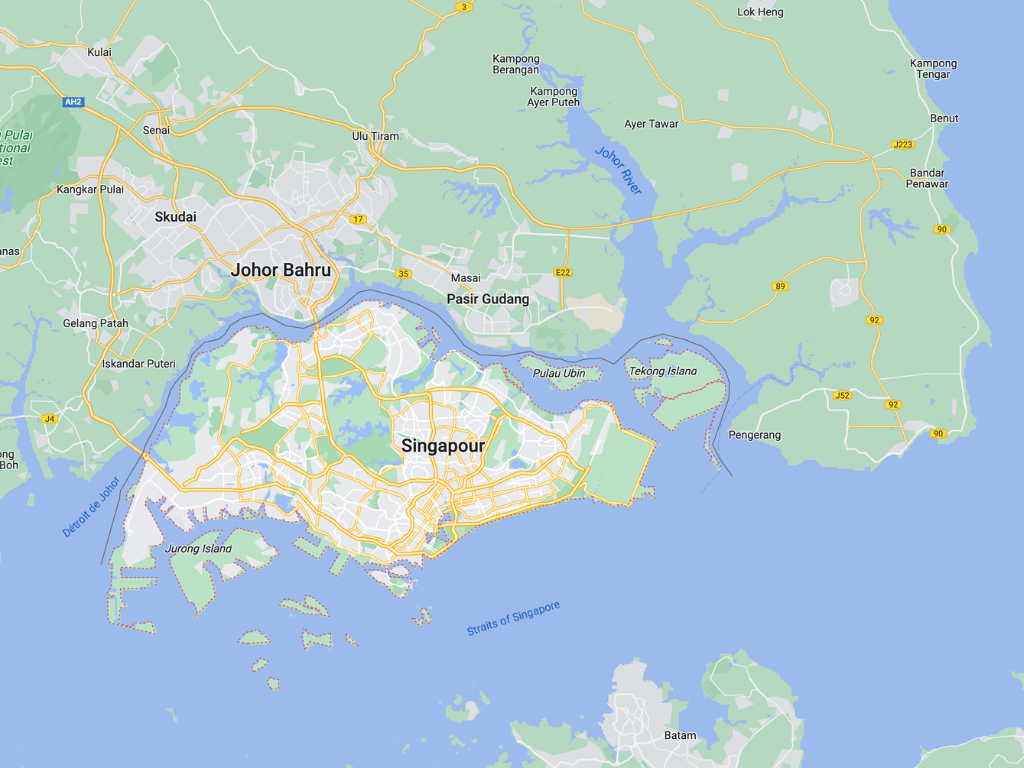

The country is part of the current themes of slow tourism: respect for nature, the cultural diversity of the population, particular attention to the general environment. The mastery of these fundamentals is accompanied by a real search for a original tourist offer.
We are supporting
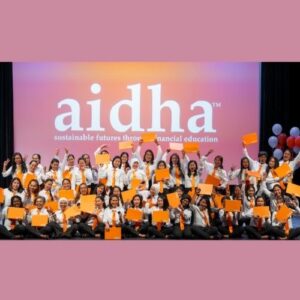
The island was named Singapura ("Lion City" in Sanskrit) in the XIV century by Parameswara (also known as Sang Nila Utama), a prince of Palembang in the south of the Indonesian island of Sumatra who is said to have gone into exile to refuse Majapahit suzerainty after an attack by him in 1377.
In fact, there has never been a lion on the island but tigers (although there is an Asiatic lion, Panthera leo persica). The explorers had probably come across a jungle beast and likened it to a lion. Singapore's symbolic animal is a fish-tailed lion, the Merlion.
TheSingapore history since adopting the name Singapura begins in the 14th century under the regime of Parameswara. After about a century and a half of domination by the British Empire, Singapore became an independent republic in 1965.
Singapore under the Lee regime was characterized by one of the highest death penalty rates in the world, and by the widespread use of administrative detention, indefinite and without trial, inflicted on both offenders and opponents. policies. The regime, based on widespread surveillance and permanent repression, served as a model for communist China.
In 1997, like other Asian states, Singapore is facing a massive influx of foreign capital which then withdraw, destabilizing the currency and then the economy of the countries.
Singapore has achieved a certain prosperity thanks to the electronics industry and especially its banking activity, constituting a particularly opaque tax haven between Asia and the West. The country is still under the authoritarian rule of the People's Action Party.
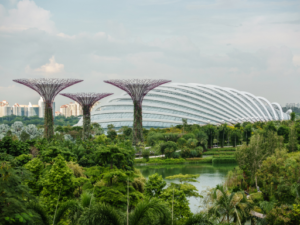
Gardens by the Bay (Gardens near the bay) is part of a strategy by the Singapore government to transform the "garden city" into a "city in a garden", with the stated aim of improving the quality of life by enhancing the city's greenery and flora. State. City where omnipresent greenery is an integral part of its urban landscape, green spaces covering more than 50% of its territory. Gardens by the Bay is Singapore's first urban outdoor recreational space and "a national icon". The park is very popular with a total of 20 million visitors in 2015 then 50 million in 2021, in 2022 it is designated the most beautiful garden in the world, It is composed of 3 Gardens:
Bay South Garden
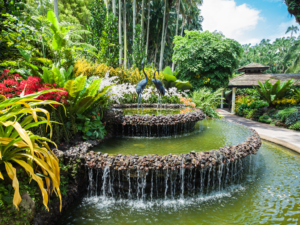
It aims to showcase the best of tropical horticulture and garden art.The overall concept of its master plan is inspired by an orchid as it is representative of the tropics and Singapore, being the national flower of the country, the Vanda 'Miss Joaquim'. The orchid takes root at the edge of the water (conservatories), while the leaves (reliefs), shoots (paths, roads and links) and secondary roots (water, energy and communication) form an integrated network of flowers (thematic gardens and Supertrees) at key intersections.
Bay East Garden
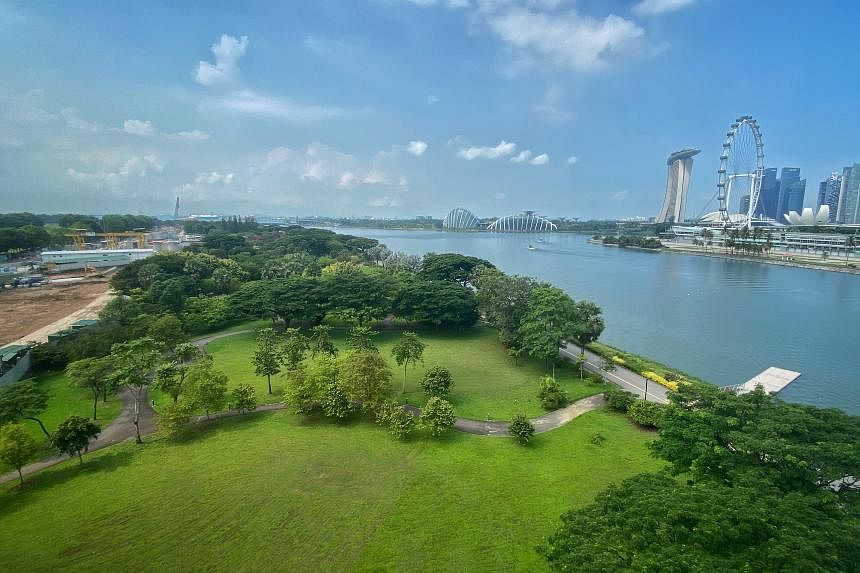
The project is designed as a series of large gardens in the shape of tropical leaves, each with its own design, character and landscaping theme. There will be five water inlets aligned with the prevailing wind direction, maximizing and extending the shoreline while allowing wind and water to enter the site to help cool the activity areas around them.Bay East Garden offers visitors a breathtaking view of the city skyline. Future Bay East Garden developments will be water-themed.
Bay Central Garden
It will serve as a link between Bay South and Bay East Gardens. It occupies 15 hectares with a 3 kilometer waterfront promenade that allows for scenic walks stretching from the city center to the east of Singapore. Bay Central Garden will be further developed in the next few years.
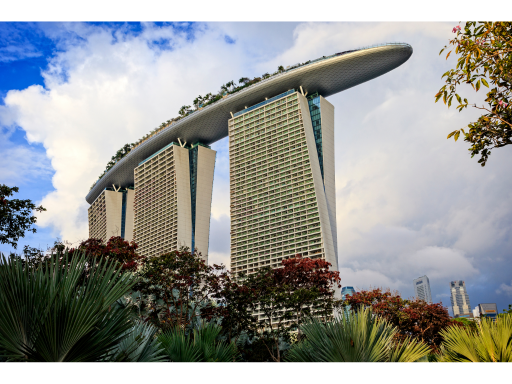
The Marina Bay Sands is a shopping and hotel complex in Singapore with 2,560 rooms, a casino and a museum (ArtScience Museum), located opposite Marina Bay.
ArtScience Museum is one of the attractions at Marina Bay Sands, an integrated resort in Singapore owned by the American company Las Vegas Sands. it is the first museum of arts and sciences in the world.
Although offering a permanent exhibition in ArtScience Gallery, ArtScience Museum mainly hosts traveling exhibitions organized by other museums or private companies.
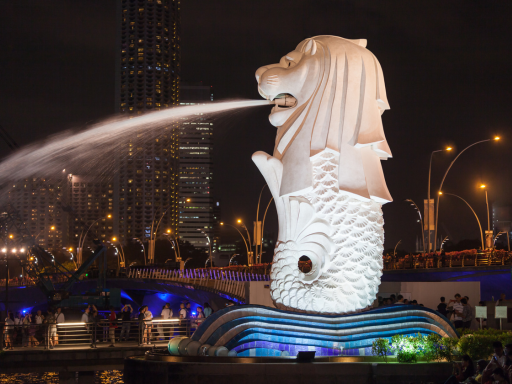
The Merlion is a lion head and fish body statue located in Singapore. The name is a neologism formed from the words mermaid ("siren ") and lion. The Merlion is the commercial emblem of Singapore.
The original Merlion statue sits at the mouth of the Singapore River in Marina Bay. According to legend, the creature's lion head and fish body recall the story of the legendary Sang Nila Utama, who made his way to Malacca , saw a lion while hunting on an island.
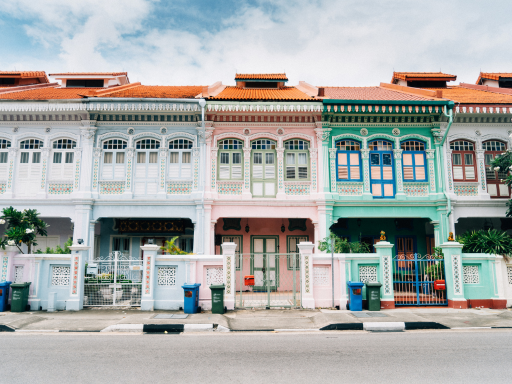
To experience Singapore's colonial past, you must visit the Colonial District on foot. North of the old mouth of the Singapore River is what might be called the Colonial Quarter of Singapore, dotted with reminders of British rule set back from the expansive lawn that is the Padang. The area still feels like the centerpiece of downtown, though modern buildings in the surrounding area constantly draw attention to it – including the towers of Marina Bay Sands and the Financial District, to the south, and the Esplanade complex – Theaters on the Bay for the Northeast. Despite the neighborhood's historical associations, there aren't many high-profile sights. Chief among these are the excellent National Museum and the Peranakan Museum, both tucked away beneath leafy Fort Canning Park, which itself is worth a visit, as is the dignified St. Andrew's Cathedral and the small Armenian Church of St. Gregory the Illuminator. However, by far the most famous building in the area is the grand old Raffles Hotel.
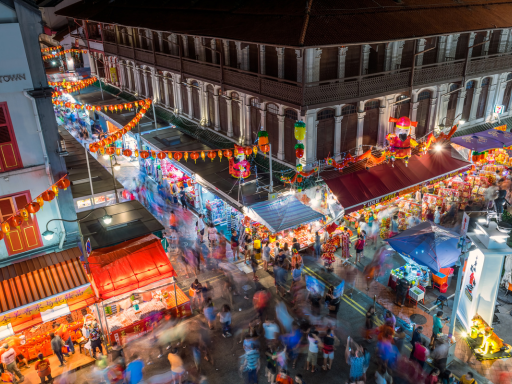
Once an enclave for Singapore's Chinese immigrant population, today's Chinatown is a mix of old and new, with historic temples and medicinal halls alongside award-winning bars and restaurants.
You can spend an entire day exploring this lively district, which encompasses the neighborhoods of Tanjong Pagar, Bukit Pasoh, Kreta Ayer and Telok Ayer.
Whether you're exploring centuries-old temples or soaking up the vibe of hip watering holes, there's always a new experience to be had in Chinatown.
Singapore has four official languages which are Mandarin, English, Malay and Tamil.
TheEnglish is the most used language in Singapore. Almost 35% ofthe population can speak English to varying degrees, it is constantly growing.
The mandarin has been promoted by the government as a common language for the Chinese, through many campaigns. Mandarin is taught there as a native language. Nearly 35% of the population speaks it.
The Malay, historical national language, is the language used for the national anthem, the national currency and for the orders in the army, use approximately 10% of the population.
The tamoul, spoken by 60% of Singapore Indians, is a language used in education, work and government. Less than 5% of the population speaks it.
5 religions dominate. According to the latest census, 33% of Singaporeans are Buddhist, 19% Muslim, 15% Christian, 11% Taoist, 5% Hindu, 0.6% have another religion and 18% have none.
Sculpture
There is the last workshop in the region that repairs and manufactures wooden statues of Chinese deities, entirely by hand, with traditional methods. https://www.saytianhng.com/

Peranakan porcelain
This community developed a refined art of living where Chinese, Malay and English settler influences blended, reaching its peak in the late 19th and early 20th centuries.
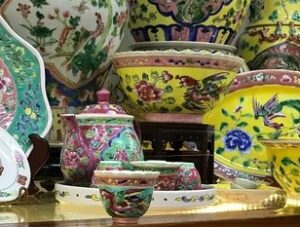
Batik fabrics
These are fabrics dyed by hand using a technique of wax reserves, we do not differentiate between the front and the back.

Traditional clothes
Singapore's traditional costume is the Peranakan costume. The Baba Nyonyas, or Peranakans, are descendants of the Chinese who settled in Malaysia, combining the different cultures and races of the country and showing the characteristics of Singapore.
A few patterns:

source: http://somerville66.blogspot.com/2019/08/peranakan-culture-and-style-singapore.html
Singaporean cuisine reflects the cultural diversity of the city-state. Chinese enclave in the Malay world, there is a wide variety of culinary styles both Chinese, Malay, but also Indonesian, English, Indian, Thai, Portuguese, Arabic, etc.
Some emblematic dishes:
Singapore noodles
Singaporean noodles are a dish of stir-fried cooked rice vermicelli, curry powder, vegetables, scrambled eggs, and meat, most commonly chicken, beef, char siu pork, or prawns.
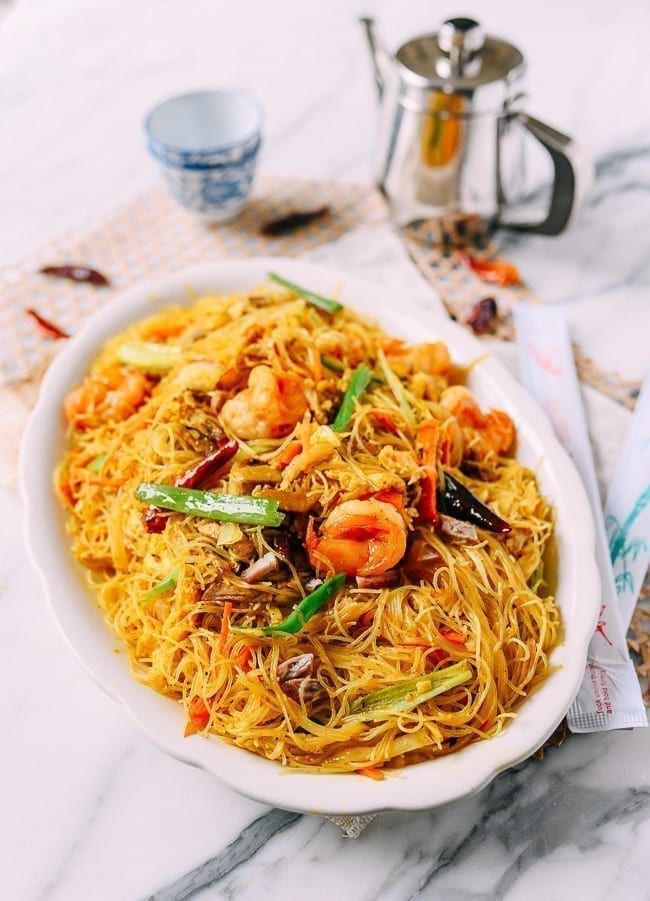
Hainanese chicken rice ou riz au poulet de Hainan est un mets d’origine chinoise, généralement associé aux régions de Hainan, de Singapour et de Malaisie, bien qu’il soit aussi commun en Thaïlande.

The fish head curry is a dish of Malaysian and Singaporean cuisine with Chinese and Indian origins. The head of a snapper is boiled in a curry with vegetables such as okra or eggplant. It is usually served with rice or bread.
Singapore has four nature areas comprising the four main nature reserves – Bukit Timah Nature Reserve, Central Catchment Nature Reserve, Sungei Buloh Wetlands Reserve and Labrador Nature Reserve – as well as 20 other areas subject to administrative guarantees within the framework of the plan for parks and water bodies.
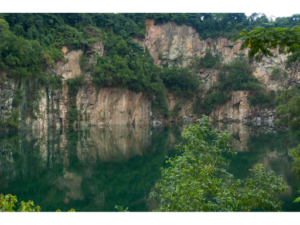 Covering an area of 164 hectares, it is located on the slopes of the hill of the same name, in the center of Pulau Ujong, the main island of Singapore. Located 12 kilometers from Downtown Core, the main business district, it is covered in equatorial forest. It is a place for walking and recreation.
Covering an area of 164 hectares, it is located on the slopes of the hill of the same name, in the center of Pulau Ujong, the main island of Singapore. Located 12 kilometers from Downtown Core, the main business district, it is covered in equatorial forest. It is a place for walking and recreation.
Acting like a big green lung located right in the center of Singapore, is the Central Catchment Nature Reserve. The largest of Singapore's nature reserves, the Central Catchment Nature Reserve occupies over 2,000 hectares of forest cover and is home to some of the most biodiverse forests.
Dipterocarp forests, which are species-rich primary lowland forests, were once abundant in Singapore before human settlements developed. Today, less than 0.5% of the original primary forest cover remains and is found only in small patches in the Central Catchment Nature Reserve and Bukit Timah Nature Reserve. An even rarer type of forest in Singapore is primary freshwater swamp forest, with the largest remaining patch being the Nee Soon swamp forest in the Central Catchment Nature Reserve.
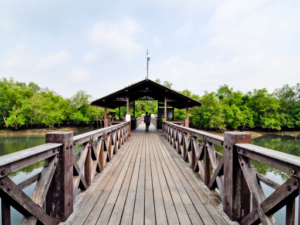 The nature reserve with an area of 202 hectares located northwest of Singapore. Made up of a mangrove. It has global importance as a crossing point for migratory birds. About 200 species of birds make up the Marine Crocodiles Reserve aresometimes observed in the reserve.
The nature reserve with an area of 202 hectares located northwest of Singapore. Made up of a mangrove. It has global importance as a crossing point for migratory birds. About 200 species of birds make up the Marine Crocodiles Reserve aresometimes observed in the reserve.
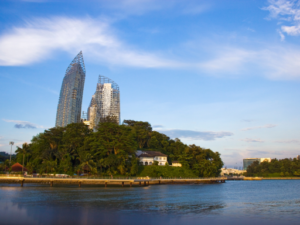 Labrador Nature Reserve also known locally as Labrador Park is located in the southern part of mainland Singapore. It is home to the only rocky cliff on the continent accessible to the public. Since 2002, 10 hectares of secondary-type coastal vegetation and its rocky shore have been classified as a nature reserve and its flora and fauna preserved by NParks. Over 70 species of birds, including the blue-crowned hanging parrot, rufous woodpecker and Abbott's talker, have been seen here. More than 11 species of butterflies have been recorded.
Labrador Nature Reserve also known locally as Labrador Park is located in the southern part of mainland Singapore. It is home to the only rocky cliff on the continent accessible to the public. Since 2002, 10 hectares of secondary-type coastal vegetation and its rocky shore have been classified as a nature reserve and its flora and fauna preserved by NParks. Over 70 species of birds, including the blue-crowned hanging parrot, rufous woodpecker and Abbott's talker, have been seen here. More than 11 species of butterflies have been recorded.
We could start from the observation: the jungle in the city!
This is a reality, which gives spice to the hikes planned by taking as a starting point:
For more information, we recommend this excellent travel blog:
Singapour, de la jungle en ville
The trip from Thailand to Singapore via Malaysia is feasible for less than 100 euros on board regular trains. But be careful, you will have to take your time! Count 45 hours of cumulative journeys on board five different trains, including two at night!
The trip is worth it! A journey of almost 3000 km!
More info on this article: https://www.lefigaro.fr/voyages/guides/de-la-thailande-a-singapour-en-train-notre-incroyable-voyage-de-3000-km-a-travers-l-asie-du-sud-est-20230415
In the city-state of Singapore, an extremely dissuasive system for motorists is in place. On average, it will be necessary to pay the tidy sum of 31 000 € to drive a car, if you have a mid-range sedan type model.
This is reflected in the rental price of the vehicles: between 50 and 80 € per day!
So consider public transport:
Singapore's public transport network works perfectly: both for its punctuality, the frequency of passages and its cleanliness.
A little surprising these stations with sometimes their many shops! Apart from that, a high frequency of trains, and significant time amplitudes: 5:30 a.m. to 12:30 a.m.
The best way to get to parts of Singapore not served by the metro. Thus, every day, more than 2 million trips are made using this means of transport.
They can be called on the street and ordered by phone or through mobile apps like ComfortDelgro Taxi Booking and Grab.
.
Find more updated information on Tourism in Singapore in our Blog Tourismer.io

Aidha offers courses for assistants in management, communication, IT and entrepreneurship.
Aidha's mission is to help migrant domestic workers and low-income Singaporean women achieve economic independence through financial education, wealth creation and entrepreneurship.
Founded in 2006, Aidha is an award-winning charity with Public Institution (IPC) status. 500 students are currently enrolled in the training programs.